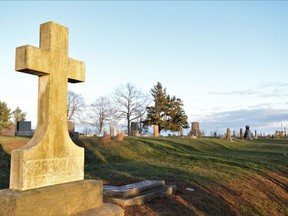
The accidental discovery of Indigenous artifacts on the grounds of Bayview Cemetery in Port Rowan could make future burials so expensive the cemetery would have to close.
Advertisement 2
Article content
Archeologists and First Nations monitors involved in habitat restoration along the Long Point Causeway noticed evidence of historical Indigenous settlement “laying in plain view” as they cut through the cemetery on Front Road to get to a nearby wetland, said David Drobitch, Norfolk’s supervisor of cemeteries , in a recent report to council.
Article content
After the county reported the sighting, as required under the Heritage Act, the province and the Bereavement Authority of Ontario recommended Norfolk launch a stage one archaeological assessment that involves consulting with Indigenous communities.
To the untrained eye, the evidence spotted in the freshly dug earth would look like loose gravel, Drobitch told The Spectator.
Advertisement 3
Article content
“Of course, the question is what else is there?” he said. “That’s what’s taken us to the stage one (assessment) and making sure we’re doing the right thing.”
The cemetery can still conduct burials, but a monitor must be on hand to oversee any digging and look for more evidence of past First Nations presence.
Depending on how widespread traces of Indigenous settlement are on the roughly three-acre site, council may eventually be forced to decide whether to close the cemetery “to be on the safe side” should more comprehensive — and expensive — archeological monitoring be required to meet provincial legislation, Norfolk’s general manager of operations told councillors.
“There could be a chance that the cemetery would become non-operational if it is a hot spot for artifacts,” Bill Cridland said.
Advertisement 4
Article content
“To operate a cemetery when you’re selling a plot for under $1,000 apiece but you’re going to end up spending $5,000 apiece, we’d have to come to this council at that time and (recommend to) cease operations.”
The stage one assessment and Indigenous consultation will cost taxpayers $40,000 and be conducted by Hamilton-based Archaeological Research Associates Ltd., which bills itself as “Ontario’s oldest archaeological and heritage consulting firm.”
Bayview, a United Empire Loyalist burial ground, dates to “roughly 1875,” Drobitch said.
Cemetery staff oversaw 14 burials of cremated remains and one full-body burial at Bayview last year.
“Hundreds” of plots remain unsold, and interment rights have already been sold for hundreds more, mostly within family plots, Drobitch said.
Advertisement 5
Article content
“It’s a fairly full rural cemetery,” he told The Spectator.
“It’s overlooking Long Point Bay. Beautiful site. Anyone would want to be buried there.”
Norfolk is responsible for covering all costs at the municipally owned cemetery, whose volunteer board of directors is “concerned” for Bayview’s future in light of the discovery, Drobitch said.
According to Drobitch, what the future holds is likely “based on feedback from First Nations communities.”

“We’re trying to be respectful to everybody,” he said of a delicate situation in which the interests of First Nations communities and the families of those buried at Bayview — and residents who plan to rest eternally there one day — need to be considered .
“My hope is that there will be recognition that this particular location is important to multiple communities and that we can work forward together,” Drobitch said.
JP Antonacci is a Local Journalism Initiative Reporter based at the Hamilton Spectator. The initiative is funded by the Government of Canada.
Article content
